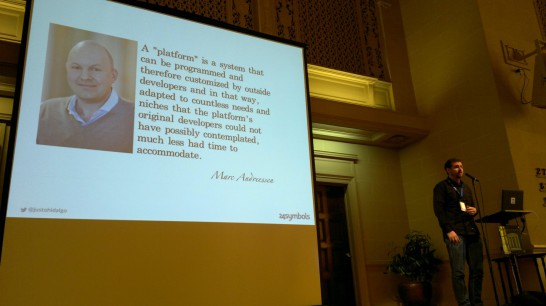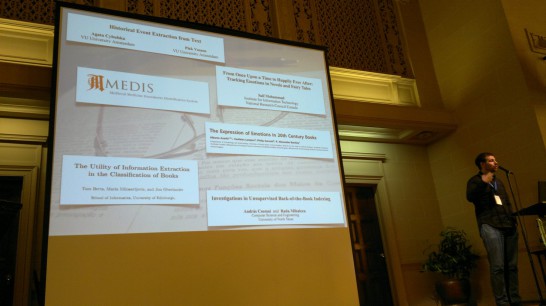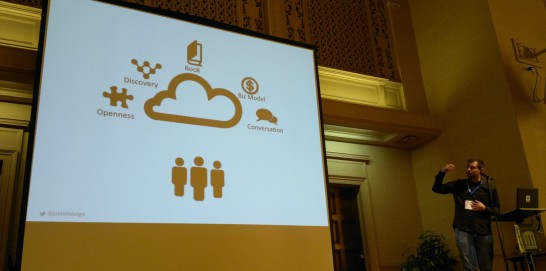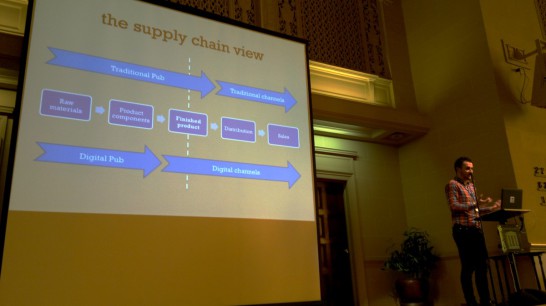Live conference notes taken Thursday October 24th during the Books in Browsers 2013 conference at the Internet Archive, San Francisco.
See an index of my live notes here.
Usual live blogging disclaimer :
These are informal notes taken by me, Manuel Schmalstieg, at the event, and may or may not be similar to what was said by the people who spoke on these topics. Probably if something here is incorrect it is because I mistyped it or misunderstood, and if anyone wants corrections, they should email me – or post a comment. Thanks!
TOC:
A Pragmatic Trip Towards a Vision
Is a ‘Books as a Service’ Platform Meaningful in Tomorrow’s Publishing World?
with Justo Hidalgo, 24 Symbols
you face crossroads, choices.
an idea we had in mind – we had to forget about it for some reasons – and it came back in a pragmatic way:
we are a service to read books on any device. a cloud service. lots of discovery capabilities. all types of mobile monetization.
quote by Marc Andreessen, definition of platform – “a system that can… ”
a platform (PaaS) is between “software as service” (SaaS), and “information as service” (IaaS).
a platform : you need to worry only about your business, not about servers, hardware, scaling…
compares to other projects. SmallDemons, Mobnotate, …
Some experiments in the industry: “The BookSmash Challenge“.
If you come from the research part, scholar part: there are many projects that try to extract data, information.
The initial idea, i had in mind 3 years ago. But as any startup, we ran in a situation known as “the valley of death” – running out of money, trying to get traction.
we found an oasis. started to work with a partner. needed to make money for our investors – the idea of the platform was forgotten.
partnered with carriers, publishers. they have subscribers. we own the relationship with the user, with the publisher.
additional business models:
– Freemium (the Spotify of books, Netflix of books).
– club: pay credits per book.
Slide showing the business structure.
Suddenly, the things we were thinking about in the beginning were coming back – the platform, the different services.
Need to take advantage of a window opportunity. We started thinking of a “level 1 platform”. Then a level 2 platform: other people can inject functionality. For example, content mining. Why not let scholars inject those functions into our platform?
How we are doing that platform? REST – RESTful API. it’s the lingua franca for cloud computing.
We have access to resources. Public comments, status changes, reading, n-grams, page views of the book, the regions.
The stats, can be available from the API.
Internationalisation.
The billing. This is a business intelligence issue, it’s still quite complex.
Examples of what we have now – API code examples, output in JSON.
Challenges: scaling the platform. What does it mean for security? Building a dashboard. Interacting with all the regions and instances.
Legal rights questions. We should be able to reach deals with content owners. This will be quite hard. But challenges are nothing if the business makes sense.
What about competition? Amazon could do this.
Next steps: we are quite pragmatic about that. We will launch services soon in south america and eastern europe.
Conclusions. We are building the core of the platform.
The Blind Men and the Elephant
with Peter Haasz, OverDrive
The blind man and the elephant is an ancient hindu fable. Also a poem from 1864 — quotes lines of the poem.
Each coming from different angles reached different conclusions of what the elephant really is.
There can be an objective truth, but our perception of it can be flawed.
What does this have to do with books?
The elephant in the room are the books.
the supply chain view:
the publisher is only producing the product components.
generic procedures are applied to each books.
if books are elephants, our reading systems are our blind men.
every reading system is different.
the experience differs.
image: EPUB3 supported features table.
devices can override settings. CSS overrides.
nothing that they are doing will resolve the issue. the specification allows for variations. some companies (A, A) have strategic interests.
describes possible strategies for publishers.
Now that is my statement for the problem – how could solutions look like?
We have increasingly sophisticated technologies. opportunities arise from this to put the power back in the publishers hands.
it’s for publishers to take back control of the publishing system.
Writing and Editing in the Browser
with Mandy Brown, Editorially
also cofounder of a book apart.
worked previously at typekit.
editorially is a new collaborative writing and editing tool.
first question: “why on earth would you do something like that”
recent review (possibly this, by Paul Ford) – other tools, medium, ghost ….
question “Why are we still looking at that problem?”
i have several answers. 1st, writing is just really important. it’s our way of sharing, past the boundaries of our own life.
recent piece in the guardian, importance of libraries. it’s a critical part. it won’t ever be a solved problem.
second question: how do we read now. we probably read more than in every point in human history. this leads to more writing, more good writing.
what’s the writing process that leads to the best possible writing?
we shifted from a print-first system, to a web-first system. but many strategies and skills from the print industries are still important. how to adapt them and learn from them?
i have a personal attraction towards publishing. there are more hybrids in this field than specialists.
things i will talk about.
– Editorial tradition
– the web standards movement: enabled the reading applications we have now.
– remote workflows: publishing often occurs across distributed teams.
– data stewardship: ensure that what we create has a long life.
editorially: a system on the web, that takes some cues from collaborative software development. has versioning built in. the history is preserved. milestones.
once you have a versioning system, it becomes trivial to compare, see what changes are happening.
core influence: the web standards movement. linked to my background in the List APart. one of the things that happened, the fact there are hundreds of different devices in this room, this depends on the web standard movement.
an example. “the great discontent”. looks different on different devices. the only way to do that is to take care of the underlying markup.
it’s part of the writer and editor’s work- they need to be involved in that. HTML is awkward as an authoring environment. we adopted Markdown. it allows to output Html cleanly and easily.
the third tradition we borrow from: remote workflow. our team is split across Brooklyn, portland, san francisco… it’s the nature of working in software development. we communicate across time and distance.
((shows the editor of editorially))
a commenting system. you can close a discussion, and reopen to contribute later.
a third place where you can communicate: the activity feed.
##Data stewardship
a lot of data has been lost, we take this very seriously. we need to think of where it’s gonna go. report about data preservation, in Contents magazine. we take those recommendations very seriously. there are multiple ways for the work to be saved during the process.
the last point offers other opportunities, once the writing process is done. it gets published, often in different contexts. let the content move.
we built Editorially on top of an API. export: content can be sent to dropbox, or to wordpress.
Core belief. good writing, and good software design, have a lot in common.
Kate Pullinger
i’m a writer, and i write novels.
the new novel will be my 8th.
i also work in multimedia, collaborative, online projects. often participatory. combined with music, media, sometimes games.
a couple of these works : … Alice … Flightpaths.
these projects are very different from my works of literary fiction.
when i cam to BiB last year (2012), i did a talk, and came with three questions.
living in two parallel worlds (literary fiction, multimedia) – those two modes were essentially the same for me as a writer. my questions last year:
– is it possible to merge those two ways of telling stories.
– will my book publisher ever be interested in my digital fiction?
– can books become spreadable media?
the notion of “the novel as API”, where could that leave us to?
in 2012, this was the answer to all three questions:
NO.
But now we move forward to 2013… and now the answer is:
YES.
(shows cover of new novel: Landing Gear)
these are the two covers, the american, and the Canadian cover. they symbolize everything that is different between the two countries.
(shows photo of her publisher)
Meghan MacDonald is at Random House canada, part of XXXX publishing group, part of YYY, part of Penguin/Random House Canada.
when i was finishing my novel, landing here, i put all that ideas into a document, including “the novel as API”, monologue, epilogue. met Meghan MacDonald here, before her company bought “Landing Gear”
she responded to that document in a tremendously exciting way – the first time a publisher responded to that.
what we are doing: indexing via characters, locations, events, timeline.
we also hope to make it writable, as well. we offer it on Books in Browsers hackday to developers.
the story of Landing Gear is the story of a Pakistani … landing at heathrow, falls out, lands on the car of a woman, and their lives (…) at this point.
it’s very much about that moment of his arrival in london – the cultural collision that takes place between them.
takes place in 2012-2014. hopes the API will allow conversation among readers. engage them to participate in the discussion.
One more aspect, the publisher got the novel, the API, got several universities involved. Talked at last BiB with John Maxwell, who will be here tomorrow.
Together we came up with the idea of working with a group of his master students, of … university. We are gonna take the existing project of Flightpath, which was made in Flash, and make a HTML5 version. And hopefully make a monetized version , to see if that is possible and works.
Challenge: how do you take an audience, take it into a literary fiction, very different from an online work? Can we bring them into long form fiction? IS that an interesting thing to do? We will face that question on 2014. Thank you.
Etienne Mineur
four years ago, i was tired about screens – but without forgetting what i learned about interactivity.
so i tried a paper-videogame. the first prototype, 5 years ago , i made “a book who would like to be a video game”
has lots of sensors, knows position in space… and can generate sound.
every page has a color and a sound.
it’s very hard!
another one: you have to push the paper to get and information. with termo-sensitive ink.
you have to find the north.
and the last one: how to play “pong with a book”
you have to move the page.
it’s a real book – of course just one.
we used a very small sensor, arduino card, small speaker. it’s not very complex to do.
an alcool sensor. blow on the book. if you are not drunk enough, the book does not work.
prototype with paper.
the book that disappears: once opened you have 20 minutes to read before it self-destructs. It’s a strange feeling, when you start to read and it disappears…
Another one: perhaps you remember the nintendo gameboy.
using arduino card. like a game, but it’s not a screen, it’s real paper. a very 80’s video game.
“The book that turns its own pages”.
it’s able to turn the pages itself.
After that, we created a small iphone application. the book is connected to the internet, it sends the location to the phone app. Tangible media send information to digital, digital sends information back.
Another prototype: it was a reaction against QR codes. for me they are the new zombies – they are everywhere.
This book *is* a video game. Apple restricted it to 17+ years. It’s a real game, you have to pick up items. And it’s impossible to win. it’s like a zombie movie – everybody will die.
Almost the same system, but it’s just paper, a cube of paper. We created a game, for children, with the same system. Every time we start with paper, and sometimes it works, just with paper.
Three years ago, my son was playing with my iphone, switched off – he used it as a plane. The idea. your mobile phone is your pawn, that you place on the map.
A french publisher asked us, “is it possible to create an atlas with this technology”? And we did.
Another one: we found a system with conductive ink. Every screen is capacitive now, an electricity sensitive system. With a silver ink, we can recognize different shapes on the screen.
A work made with students in Geneva: “Once upon a tale”.




